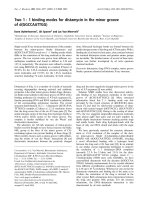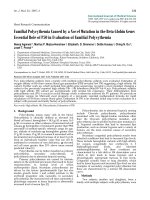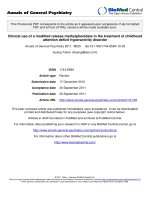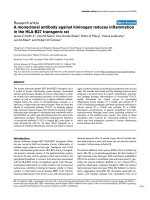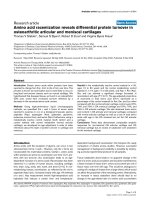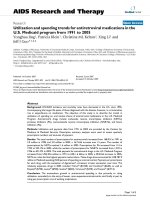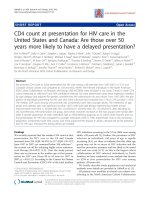Báo cáo y học: "Pressure support ventilation attenuates ventilator-induced protein modifications in the diaphragm" pptx
Bạn đang xem bản rút gọn của tài liệu. Xem và tải ngay bản đầy đủ của tài liệu tại đây (39.97 KB, 2 trang )
Page 1 of 2
(page number not for citation purposes)
Available online />Abstract
Common medical conditions that require mechanical ventilation
include chronic obstructive lung disease, acute lung injury, sepsis,
heart failure, drug overdose, neuromuscular disorders, and surgery.
Although mechanical ventilation can be a life saving measure,
prolonged mechanical ventilation can also present clinical problems.
Indeed, numerous well-controlled animal studies have demonstrated
that prolonged mechanical ventilation results in diaphragmatic
weakness due to both atrophy and contractile dysfunction.
Importantly, a recent clinical investigation has confirmed that
prolonged mechanical ventilation results in atrophy of the human
diaphragm. This mechanical ventilation-induced diaphragmatic
weakness is important because the most frequent cause of weaning
difficulty is respiratory muscle failure due to inspiratory muscle
weakness and/or a decline in inspiratory muscle endurance.
Therefore, developing methods to protect against mechanical
ventilation-induced diaphragmatic weakness is important.
It is well established that controlled mechanical ventilation
(CMV) results in a rapid onset of diaphragmatic proteolysis,
atrophy, and contractile dysfunction in a variety of animal
models [1-4]. CMV-induced diaphragmatic atrophy occurs
due to increased proteolysis and a decreased rate of protein
synthesis [5,6]. Importantly, this ventilator-induced diaphrag-
matic wasting is not limited to laboratory animals as recent
evidence confirms that prolonged CMV also results in
diaphragmatic atrophy in humans exposed to 18 to 69 hours
of mechanical ventilation [7]. Ventilator-induced diaphragmatic
weakness is clinically significant because diaphragmatic
dysfunction can be an important contributor to weaning
difficulties. Therefore, developing strategies to prevent
ventilator-induced diaphragmatic weakness is imperative.
Using an animal model of mechanical ventilation, a recent
paper by Futier and colleagues [1] reports that the increased
diaphragmatic protein turnover observed during CMV can be
prevented by using a pressure support mode of mechanical
ventilation. Specifically, this study suggests that pressure
support ventilation is efficient in maintaining diaphragmatic
protein synthesis and retarding CMV-induced diaphragmatic
proteolysis. Although this work provides several interesting
observations, these experiments did not include direct
measurements of diaphragmatic fiber cross-sectional area or
the assessment of diaphragmatic contractile function. These
additional measures would have greatly improved our under-
standing of the clinical benefit provided by this mode of
mechanical ventilation. For example, in similar experiments,
Sassoon and colleagues [8] reported that assist-control
mechanical ventilation attenuated the diaphragmatic contrac-
tile dysfunction induced by complete diaphragmatic inactivity
during CMV. Nonetheless, three days of assist-control mech-
anical ventilation resulted in a 20% reduction in diaphrag-
matic peak power output without significant changes in both
diaphragmatic contractile proteins and the expression of a
key protein (MAF-box) involved in the proteasome system of
protein degradation [8]. Therefore, measurement of the rates
of protein synthesis and degradation alone do not necessarily
reflect the functional status of the diaphragm.
Futier and colleagues [1] also conclude that CMV and
pressure-assist mechanical ventilation result in a similar level
of diaphragmatic myofibrillar protein oxidation. This argument
is based upon the measurement of a single biomarker of
oxidative damage (that is, protein carbonyls). We believe that
this conclusion is unwarranted for the following reason.
Oxidized proteins in cells are rapidly degraded by the 20S
proteasome and increased 20S proteasome activity would
likely increase the turnover rate of these damaged proteins
[9]. This is significant because Futier and colleagues [1]
report that the activity of the 20S proteasome is increased in
Commentary
Pressure support ventilation attenuates ventilator-induced
protein modifications in the diaphragm
Scott K Powers
1
, Marc DeCramer
2
, Ghislaine Gayan-Ramirez
2
and Sanford Levine
3
1
Department of Applied Physiology and Kinesiology, University of Florida, Gainesville, FL 32608, USA
2
Respiratory Rehabilitation and Respiratory Division, University Hospitals, Catholic University of Leuven, B-3000 Leuven, Belgium
3
Department of Surgery, University of Pennsylvania School of Medicine, Philadelphia, PA 19104, USA
Corresponding author: Scott K Powers,
Published: 7 November 2008 Critical Care 2008, 12:191 (doi:10.1186/cc7095)
This article is online at />© 2008 BioMed Central Ltd
See related research by Futier et al., />CMV = controlled mechanical ventilation.
Page 2 of 2
(page number not for citation purposes)
Critical Care Vol 12 No 6 Powers et al.
diaphragms from animals exposed to CMV whereas animals
ventilated using pressure support do not exhibit elevated 20S
proteasome activity. Therefore, protein turnover of oxidized
proteins would likely be greater in the diaphragms of CMV
animals compared to pressure support animals. It follows that
comparing the levels of protein carbonyls from these two
experimental groups can not lead to the conclusion that similar
levels of protein oxidation existed between these groups.
Finally, Futier and colleagues [1] also state that diaphrag-
matic protein oxidation probably does not trigger the
proteolytic process that occurs during CMV. This postulate
may be correct but this report does not provide data to
support this supposition. In contrast, studies from our
laboratory indicate that the prevention of CMV-induced
diaphragm oxidative damage via antioxidants retards CMV-
induced diaphragmatic proteolysis and atrophy [10,11].
Moreover, there is abundant evidence to suggest that distur-
bances in redox balance may play a significant signaling role
in several different forms of muscle wasting [12].
In summary, we applaud the authors’ attempt to improve our
knowledge regarding the impact of different modes of
mechanical ventilation on diaphragmatic protein turnover.
However, future studies on this topic should include more
decisive measures of redox balance along with diaphragmatic
contractile measurements and the assessment of muscle
fiber atrophy. Moreover, additional mechanistic studies are
required to better understand the signaling pathways
responsible for the rapid onset mechanical ventilation-
induced diaphragmatic wasting and contractile dysfunction.
Competing interests
The authors declare that they have no competing interests.
References
1. Futier E, Constantin JM, Combaret L, Mosoni L, Roszyk L, Sapin
V, Attaix D, Jung B, Jaber S, Bazin JE: Pressure support ventila-
tion attenuates ventilator-induced protein modifications in the
diaphragm. Crit Care 2008, 12:R116.
2. Powers SK, Shanely RA, Coombes JS, Koesterer TJ, McKenzie M,
Van Gammeren D, Cicale M, Dodd SL: Mechanical ventilation
results in progressive contractile dysfunction in the
diaphragm. J Appl Physiol 2002, 92:1851-1858.
3. Gayan-Ramirez G, de Paepe K, Cadot P, Decramer M: Detrimen-
tal effects of short-term mechanical ventilation on diaphragm
function and IGF-I mRNA in rats. Intensive Care Med 2003, 29:
825-833.
4. Sassoon CS, Caiozzo VJ, Manka A, Sieck GC: Altered
diaphragm contractile properties with controlled mechanical
ventilation. J Appl Physiol 2002, 92:2585-2595.
5. Shanely RA, Zergeroglu MA, Lennon SL, Sugiura T, Yimlamai T,
Enns D, Belcastro A, Powers SK: Mechanical ventilation-
induced diaphragmatic atrophy is associated with oxidative
injury and increased proteolytic activity. Am J Respir Crit Care
Med 2002, 166:1369-1374.
6. Shanely RA, Van Gammeren D, DeRuisseau K, Zergeroglu M,
Michael J, McKenzie M, Yarasheski K, Powers SK: Mechanical
ventilation depresses protein synthesis in the rat diaphragm.
Am J Respir Crit Care Med 2004, 170:994-999.
7. Levine S, Nguyen T, Taylor N, Friscia ME, Budak MT, Rothenberg
P, Zhu J, Sachdeva R, Sonnad S, Kaiser LR, Rubinstein NA,
Powers SK, Shrager JB: Rapid disuse atrophy of diaphragm
fibers in mechanically ventilated humans. N Engl J Med 2008,
358:1327-1335.
8. Sassoon CS, Zhu E, Caiozzo VJ: Assist-control mechanical ven-
tilation attenuates ventilator-induced diaphragmatic dysfunc-
tion. Am J Respir Crit Care Med 2004, 170:626-632.
9. Grune T, Merker K, Sandig G, Davies KJ: Selective degradation
of oxidatively modified protein substrates by the proteasome.
Biochem Biophys Res Commun 2003, 305:709-718.
10. McClung JM, Kavazis AN, Whidden MA, DeRuisseau KC, Falk DJ,
Criswell DS, Powers SK: Antioxidant administration attenuates
mechanical ventilation-induced rat diaphragm muscle atrophy
independent of protein kinase B (PKB Akt) signalling. J
Physiol 2007, 585:203-215.
11. Betters JL, Criswell DS, Shanely RA, Van Gammeren D, Falk D,
Deruisseau KC, Deering M, Yimlamai T, Powers SK: Trolox atten-
uates mechanical ventilation-induced diaphragmatic dysfunc-
tion and proteolysis. Am j Respir Crit Care Med 2004, 170:
1179-1184.
12. Powers SK, Kavazis AN, McClung JM: Oxidative stress and
disuse muscle atrophy. J Appl Physiol 2007, 102:2389-2397.

